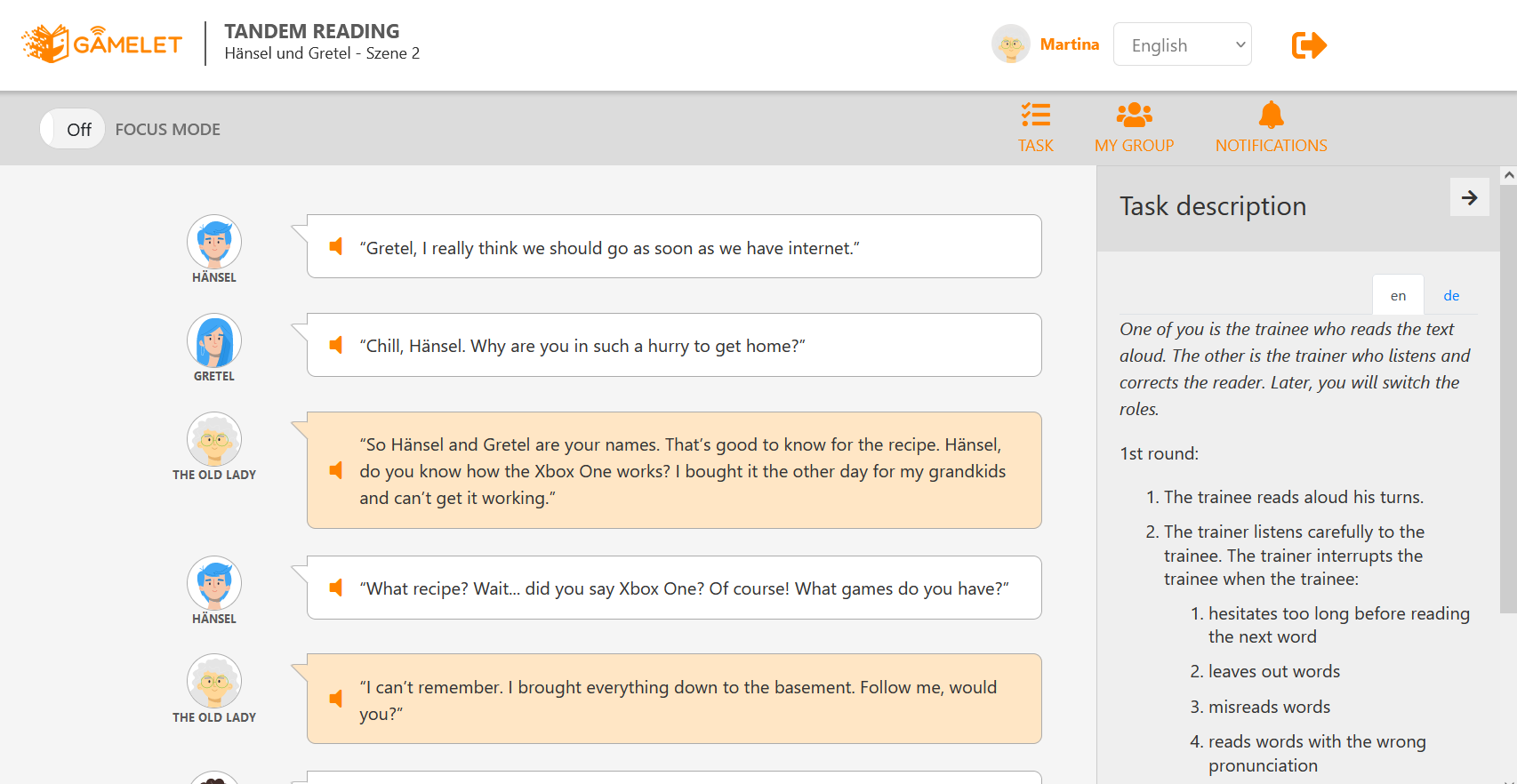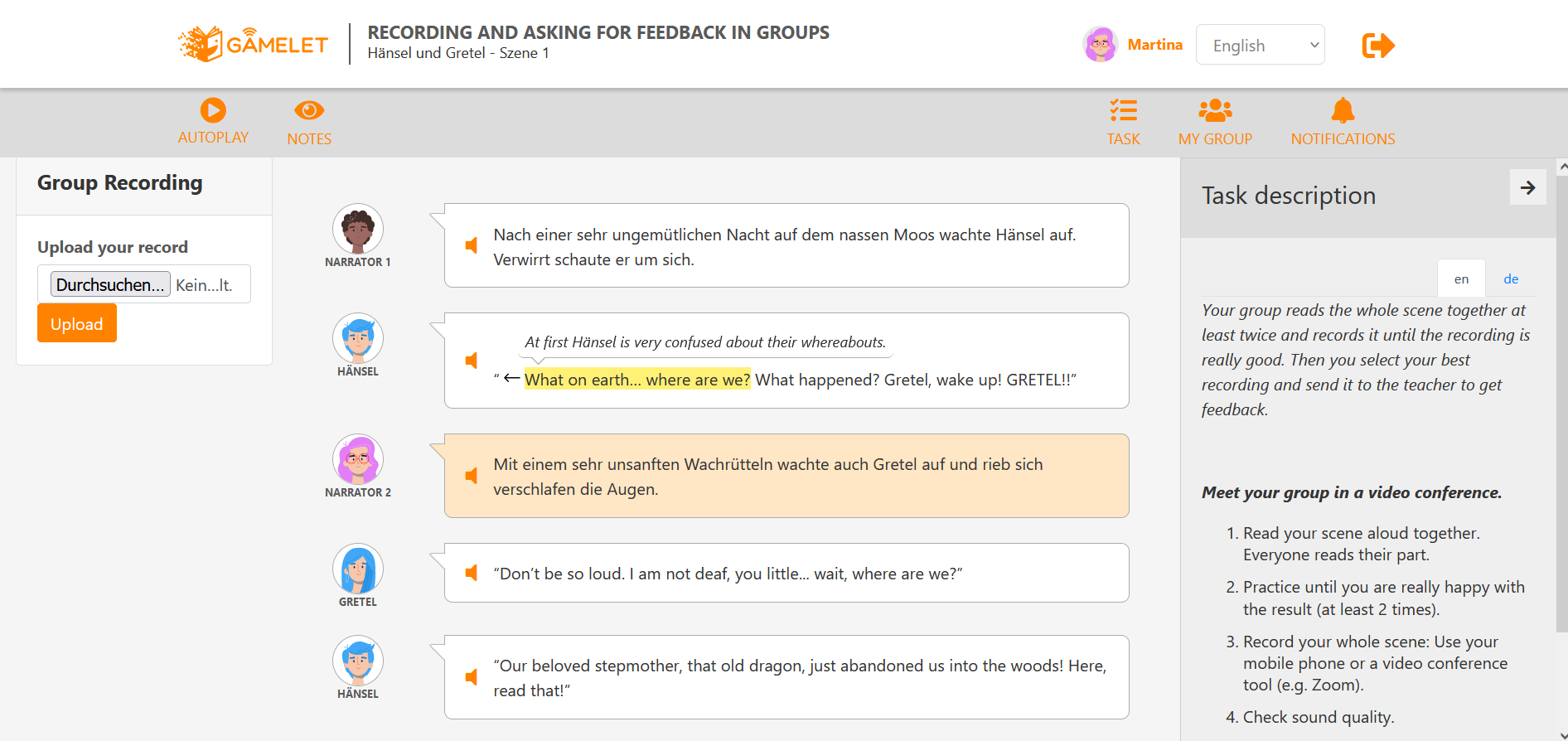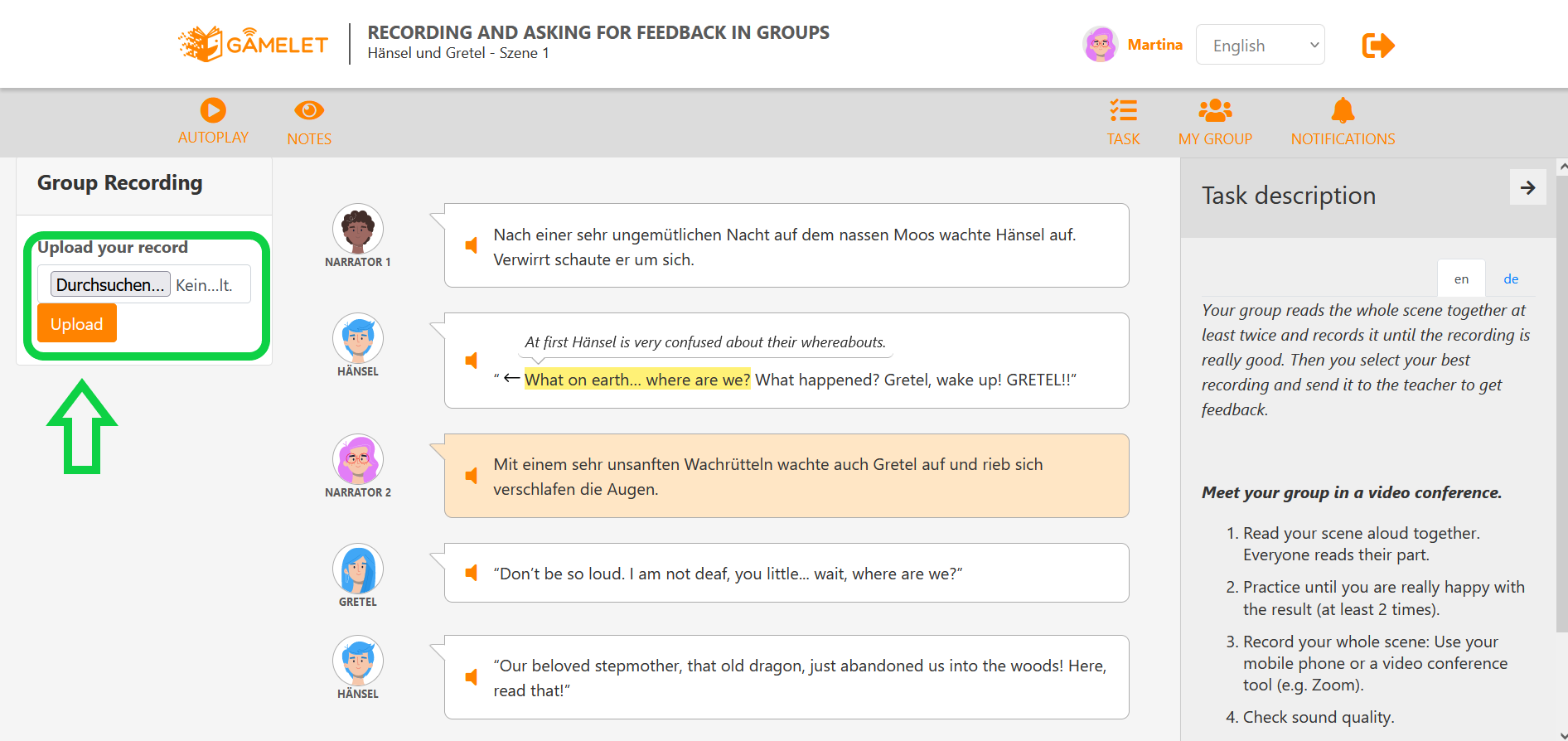5.4.3. Introduction to collaborative practice
Methodological commentary
When a group reads a script, or parts of it aloud, the coordination of reading with others in terms of intonation and time becomes apparent to learners. Moreover, this activity demonstrates the importance of each reader’s contribution for the overall effect of the script. When practicing in a group, learners are better able to get into character, read expressively, and use more gestures and facial expressions (Kutzelmann, Massler, and Peter, 2016). The reason is that learners can become inspired when looking at their peers while reading, whether on screen or face-to-face. In this way, readers are better able to improve their overall prosodic composition.
After extensive practise, the group members read their script several times in order to record their scene. Then, they choose their best recording and send it to their teacher for feedback. In this way, learners need to listen critically to their reading, reflect on the quality of the recording, and consider where they need to draw advice for improvement. The sum of these activities strengthens learner awareness of good reading aloud criteria.
Task Description
By means of video conferencing, learners work collaboratively on their script from their home. As a group, learners practise their reading and give feedback to each other. By the end of these activities, the students will have been exposed to different collaborative practise dynamics.
- Mirror Reading
| Short task description | Learners practise their role after listening to a peer reading. |
|---|---|
| Aims | To foster reading fluency by means of repetitive reading with a special focus on imitation of model reading expression, volume and phrasing. |
| Social format | Pairs |
| Synchronous/ asynchronous mode |
Synchronous |
| Feedback | Peer feedback |
| Time needed | Approximately 15 minutes |
Task description
Learners practise their scene in pairs. The stronger reader begins reading with a particular intonation pattern that the weaker reader should imitate (i.e., mirrors), followed by a reversal of modeling and mirroring roles. The focus of this task is to practise expression and phrasing. The aim is to master reading fluency and ability to imitate a peer’s reading with respect to expression, volume and intonation.
Using the game
For this task, you should pay attention to expression, volume and phrasing of the model reading. You can also print out the Feedback Guidelines that help with giving feedback to your reading partner. To make the activity more entertaining, you may mirror each other’s reading with exaggerated or funny intonation.
- Meet your partner in a video conference.
- Decide who will be the trainer and who will be the trainee.
- The trainer should read the highlighted sentence aloud.
- The trainee then imitates the trainer’s expression and volume.
- The trainer gives the trainee feedback. You can use the Feedback Guidelines.
- Swap trainer and trainee roles, and repeat the activity. You should read as long as the highlighted text appears on screen.
Awarding points: 50 points
- Tandem Reading
| Short task description | In this task, students read aloud to each other and give each other feedback. Pupils enact and alternate both roles of trainer and trainee. |
|---|---|
| Aims | Practising reading aloud and to improve reading fluency with the help of a model reader assistance. |
| Social format | Pairs |
| Synchronous/ asynchronous mode |
Synchronous |
| Feedback | Peer feedback |
| Time needed | 20 min |
Task description
In this task, students read aloud to each other. One student plays the trainer, who gives feedback, while the other student plays the trainee, who reads aloud his/her role. The students then trade positions so that in the end, both enact the roles of trainer and trainee.
Using the game
In this activity, each of you will play trainer and trainee. To begin with, one of you will play the trainee who reads his/her text aloud. The other student will play the trainer who listens and corrects the reader, if need be. After a round of trainer and trainee role playing, the players will switch roles and start again.
1st round:
- The trainee reads his/her turns aloud.
- The trainer listens carefully to the trainee and interrupts only when the trainee:
- hesitates too long before reading the next word
- leaves out words
- misreads words
- reads words with the wrong pronunciation
- Then the trainer reads the word/sentence correctly and the trainee repeats the whole sentence.
2nd round:
- You change roles: this time the new trainee practises his role.
Awarding points: 50 points
- Reading With the Teacher (Echo Reading)
| Short task description | Learners practise reading aloud by imitating their teacher, followed by imitating their peers. |
|---|---|
| Aims | To foster reading fluency: repeat/imitate teacher intonation, expression and emotion |
| Social format | In groups |
| Synchronous/ asynchronous mode |
Synchronous (f2f or video conference) |
| Feedback | Direct teacher feedback |
| Time needed | Dependent on reading level |
Task description
The teacher sets up a meeting time, either during class or in a video conference, and invites specific learners to an intensive practice phase. During this phase, learners practice their scene by imitating the teacher. In plenary, the teacher reads aloud randomly selected texts. One by one, learners must read these texts aloud while using the same intonation, expression and emotion as the teacher (echo reading). Feedback emphasis is put on phrasing and smoothness. This process is repeated three times. In the first round of the game, the teacher reads phrases/short sentences (3-5 words). In the second round, the teacher reads longer sentences (5-10 words) and in the last round, the entire turn is read. For each round of the game, learners should repeat the teacher one after the other. This process is repeated as many times as is needed until learners achieve the teacher’s expected phrasing and smoothness.
Using the game
The game consists of three rounds. In each round, your teacher will read a part of the text that you will imitate (echo reading).
- Listen carefully to your teacher.
- Each of you will have a turn to repeat and imitate your teacher’s reading.
- In each round, you may ask for feedback from the teacher.
Total possible points: 50 points
- Recording and asking for feedback in groups
| Short task description | Learners practise reading aloud by rehearsing their roles in the context of the whole play with a group, by using a conferencing platform either Microsoft Teams, Zoom, etc. |
|---|---|
| Aims | To foster reading fluency |
| Social format | In groups |
| Synchronous/ asynchronous mode |
Synchronous (video conference) |
| Feedback | Direct teacher feedback |
| Time needed | 20 minutes |
Task description
In two or three practice runs, learners rehearse the entire scene with their group, which they should record. When the group is satisfied with their recording, they send it to the teacher for feedback. Here, learners should pay special attention to intonation and smoothness of each text passage (role), and aim towards recording the entire script at the same reading level.
Using the game
Your group will read the whole scene at least twice and record the readings until you and your group feel the recording is very good. Then you select your best recording and send it to the teacher to get feedback.
Meet your group in a video conference.
- Everyone reads their scene roles aloud.
- Practice until you are happy with the results (at least 2 times).
- Record your whole scene: Use your mobile phone or a video conference tool (e.g. Zoom).
- Check the sound quality.
- Select your favourite recording.
- Upload your recording and ask your teacher for feedback.
Awarding points: 50 points
- Receiving Group Feedback From Peers and Teachers
| Short task description | During these phases, students receive feedback on their recordings from their peers and teacher. |
|---|---|
| Aims | Improve reading fluency by means of feedback |
| Social format | If possible collaborative, otherwise individual |
| Synchronous/ asynchronous mode |
asynchronous |
| Feedback | Receiving feedback in the form of a text message and/or audio messages. |
| Time needed | Dependent on the extent of feedback |
Task description
During this phase, students receive feedback on their recordings.
Using the game
- Look for feedback here:

- Open your feedback:

- Check the rating you have received by reading the text message and/or listening to the audio feedback.
- Reflect on your feedback: How can you improve your reading?
Total possible points: 50 points, individual points by teacher optional




